With the blink of an eye, humans are able to extract more information than advanced computer vision systems. An image is translated from millions of pixels in seconds, and we are able to not only recognize objects and other humans, but also perceive social interactions.
How are humans capable of completing this task so quickly and accurately? What happens in the human brain when we transform visual stimuli into complex representations and information?
Leyla Isik, former Hopkins undergraduate student and current principal investigator of the Isik Lab, aims to answer these questions by investigating the complexities of human vision and the underlying neural computations.
As an undergraduate Biomedical Engineering student, Isik first became interested in the topic of vision through a neuroscience class she took at Hopkins. She continued to explore her new interest by joining Rene Vidal’s lab, where she conducted research in computer vision. From Hopkins, Isik continued to pursue her passion in vision science and went on to discover cognitive neuroscience research while completing her doctorate at MIT. She also worked as a postdoc at the Center for Brains, Minds and Machines with Nancy Kanwisher and Gabriel Kreiman before returning to Hopkins.
Isik added that her background primarily focused on object recognition. Object recognition is our ability to see objects in the world and identify them. We have the ability to recall when we have seen an object before.
“When you walk around the world you can recognize that that’s your laptop or you know that’s a door,” explained Isik in an interview with The News-Letter.
Currently the Isik lab is focused on vision’s role in social interaction and perception. The lab uses a variety of techniques, such as human neuroimaging, intracranial recordings, behavior and machine learning to understand the neural basis of social interaction perception.
“Now what my lab studies and what I have gotten really excited about recently is social vision,” Isik said. “You can extract so much rich social information about other people, like what they are doing or thinking just from visual input.”
Part of our social vision experience includes identifying and understanding other people’s social interactions. The speed of neural computations behind this ability is mostly unknown.
The lab recently published a paper that explains the usage of magnetoencephalography (MEG) decoding to help explain how we detect social interactions. The MEG measured a subject’s response to images depicting a pair of people socially interacting together, acting alone or one person watching the other. This helped with understanding the speed at which humans process social interactions.
The lab is in the process of conducting multiple studies to learn how people group different actions, how these actions are represented in the brain and how these brain representations compare to computer vision models.
Ultimately, Isik said they aim to understand the neural computations underlying our ability to extract social information. In order to do this, the lab conducts studies which show different visual stimuli to subjects on a computer and measure their reactions.
They utilize neuroimaging to collect measurements. MRI and EEG imaging provide information about the human brain’s response to visual stimuli and indirectly measure how neurons respond to different images. The analysis of the data is computerized. Additionally, the lab participates in pure computational modeling.
Isik describes her research as a mix of both experimental and computational.
With the growing use of technology in all disciplines, Isik emphasizes the importance of the intersection between computer science, neuroscience and cognitive science. In today’s digital age, researchers are more readily integrating the field of computer science into basic science and clinical research.
This generation of research scientists use cloud software to collect data and AI to answer more complex questions.
“You can put experiments online and get behavioral responses to them at a really large scale,” Isik said.
Technology is a vital research tool. The neural networks of the brain are often modeled by computational systems. Isik noted that through computer vision algorithms and machine learning tools, she is able to learn more about the human mind and can efficiently interpret neuroscience and cognitive science data.
“A lot of computer vision algorithms can gain insight from what the brain is doing and how the human mind is solving these problems,” Isik said. “I think this interplay is really important for making progress in this area.”
In general, Isik said that research is an important skill that leads to a better understanding of a topic or discovery of a new one. It allows for the synthesis of observations, knowledge and data in order to shed light on topics with key questions, such as the ones she proposes in computational cognitive neuroscience.
“It’s so cool that your job is to figure out what problems are out there to solve and figure out how to solve them,” Isik said.





